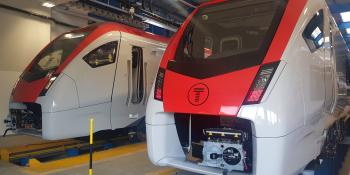
THE VOLUME of rail freight moved in the first quarter of 2018-19 (April to June) rose by 3% compared to the previous year, according to data from the Office of Rail and Road.
The total of 4.3 billion net tonne kilometres was up 0.1 billion on the same period in 2017-18. The increase follows a sustained period of declining freight traffic, largely driven by the decline in coal as the Government phases out coal-fired power stations. Despite this, the volume of coal moved was up 7% during the quarter, which ORR says may be due to coal being moved further to plants which are yet to close.
The most significant rise during the three-month period was in construction traffic, which also grew by 7% and recorded its largest ever volume of freight moved during a quarter. Construction accounted for 27% of freight moved during Q1, second only to domestic intermodal, which accounted for 39%. The only sectors that saw a decline were oil and petroleum (down 2%) and international (down 1%).
The amount of freight lifted in Q1 was 19.1 million tonnes, up 2% on the same period last year. This marks the first rise in this measure for Q1 in five years but remains the second lowest total for the quarter since the time series began over 20 years ago; the freight lifted measure takes no account of the distance travelled. The amount of coal lifted was down 2% and is the lowest in a Q1 period since the time series began.
The total number of freight train kilometres also rose, by 3% to 8.4 million, although this is the third lowest total for the spring period since the time series began in 2010-11. DB Cargo, the largest operator, saw a 10% drop in freight train kilometres, but four of the seven operators saw an increase, notably GB Railfreight with a 28% uplift. DB Cargo, Freightliner Intermodal and GB Railfreight accounted for 86% of all freight train kilometres travelled during the quarter.
Normalised freight delay during the three-month period rose to 11.3 minutes per 100 train kilometres, up 13% on the previous year



